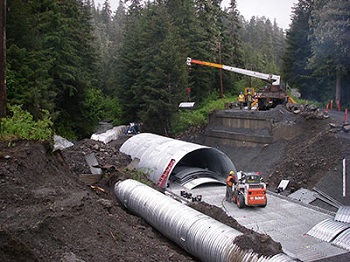Expert Road Construction Solutions for Smooth Traveling
Expert Road Construction Solutions for Smooth Traveling
Blog Article
Culvert Installation Facilitated: Step-by-Step Overview for Success
From choosing the ideal culvert size to incorporating appropriate drain actions, each action in the installment procedure plays a vital function in the capability and long life of the culvert system. Stay tuned to reveal the necessary actions and considerations that can make culvert installation a smooth and effective venture.
Picking the Right Culvert Dimension
Selecting the ideal culvert size is important for guaranteeing effective water circulation and structural integrity in culvert installment jobs - Pad Construction. The dimension of the culvert straight influences the circulation ability of water via the framework. A culvert that is too small can cause flooding and overflow, while one that is too large may result in lowered water speed, potentially causing sediment accumulation and obstructions
To identify the ideal culvert dimension, elements such as the watershed area, height flow rates, and hydraulic efficiency demand to be carefully taken into consideration. Calculations based on these specifications aid in selecting a size that can sufficiently manage the expected water volume while minimizing the threat of obstructions and structural failing.
It is important to speak with design guidelines and criteria to make certain that the selected culvert dimension satisfies the project needs and regional laws (Pad Construction). By selecting the best culvert dimension, project managers can optimize water circulation, stop prospective concerns, and enhance the general efficiency and durability of the culvert installment
Preparing the Installation Site
Effective culvert setup requires thorough preparation of the setup website to guarantee ideal architectural assistance and functionality. Before commencing the setup procedure, it is critical to remove the website of any kind of debris, plants, or blockages that could restrain the culvert's placement. Guaranteeing a degree foundation is crucial for the correct positioning and security of the culvert. This may involve rating the site to develop a smooth, even surface that can effectively sustain the weight of the culvert and any expected tons. Furthermore, correct compaction of the dirt underneath the culvert is needed to prevent settling or moving gradually.
Additionally, it is necessary to consider variables such as soil composition, groundwater levels, and environmental influences when preparing the installation website. Carrying out an extensive site evaluation can assist recognize any type of possible obstacles or threats that might affect the culvert's performance. By taking the time to prepare the installation site appropriately, you can aid guarantee an effective culvert setup that meets structural demands and guarantees long-lasting capability.
Placing the Culvert Correctly

The quality at which the culvert is placed is critical for maintaining a proper slope for water flow. Furthermore, the culvert must be oriented correctly to guarantee that the inlet and visite site outlet are in the correct places. Pad Construction.
Backfilling and Compacting the Soil
Appropriate backfilling and compaction of the soil around the culvert is important to ensure stability and avoid possible concerns in the future. As soon as the culvert is properly put, the next crucial action is to backfill the location around it with suitable material. The backfill material need to be complimentary from rocks, debris, and natural issue to avoid damage to the culvert. It is recommended to utilize granular material such as sand or crushed rock for backfilling, as it offers good drain and compaction residential or commercial properties.
Compaction aids in reducing the possibilities of settlement and guarantees consistent assistance around the culvert. It is crucial to small the dirt evenly on all sides of the culvert to maintain its structural stability.
Appropriate backfilling and compaction not just give stability to the culvert however also help in preventing dirt disintegration and keeping the longevity of the culvert system.
Ensuring Correct Drain Assimilation
Incorporating reliable drain remedies plays an essential role in the total performance and long you can try this out life of culvert installations. Appropriate water drainage assimilation is important for handling water flow, avoiding erosion, and ensuring the structural honesty of the culvert system. To accomplish this, it is important to develop a thorough water drainage strategy that takes into consideration factors such as the volume of water expected, the topography of the location, and the kind of soil existing.

Additionally, incorporating features like disintegration control procedures, such as riprap or plants, can better boost the efficiency of the water drainage system. By meticulously intending and applying these drain solutions, culvert setups can operate efficiently and stand up to the test of time.
Conclusion
To conclude, appropriate culvert setup is essential for keeping effective drain systems. By selecting the right culvert size, preparing the installment site, positioning the culvert properly, backfilling and compacting the dirt, and guaranteeing correct drainage integration, success can be achieved. Complying with these actions will help guarantee the longevity and performance of the culvert, eventually contributing to the general success of the water drainage system.
Report this page